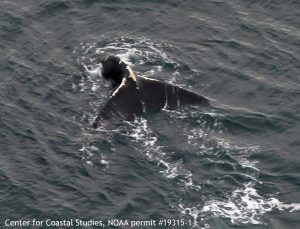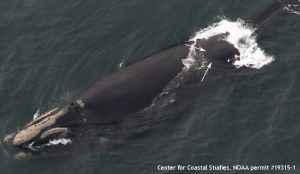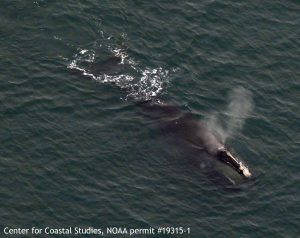Field Notes February 2018
Ahh….. winter fieldwork! We have been eagerly awaiting our next flight for the past two weeks and with today’s relatively low winds, the aerial team was finally able to get up and have a look around. The day was full of excitement with finding a group of right whales involved in social behavior and having to pause our survey by landing back in Provincetown while a freak snow squall blew through. In total, we found 13 right whales, most of who were doing long fluking dives, and many of whom we hadn’t yet seen this year.
We got a great start to the day, taking off from Provincetown airport at 8:30 am and finding very good survey conditions. We flew south down the backside of Cape Cod Bay and then worked our way north from the Cape Cod canal. All was quiet until just north of the middle of the bay where we suddenly saw two right whales just below the surface! One of these animals was EgNo 1706, a known female and one of our most frequently sighted individuals. She was one of the animals seen on our first survey of the year and has apparently stuck around.

Three right whales in a SAG – EgNos 1708, 3020 (Giza) and 3245. Cape Cod Bay, 2/6/18. NOAA permit #19315-1
Today we saw our first Surface Active Group in over a year! We refer to them as SAGs, and they essentially involve two or more whales touching and rolling around at the surface. Initially we just saw two whales (a male and female), but then we saw another whale traveling directly towards the group (we call these “approachers”). The whales rolled around and over one another very slowly, with tails and flippers and heads all coming to the surface and then disappearing again. It was difficult to tell what was going on, but very exciting. After just over three minutes, the action split up, the whales fluked and we moved on.
Back at the lab, we realized that there had been four right whales involved in the SAG; three males, and a “focal female”. The female was generally at the center of the group, and often with her belly up, as the males moved around her. The males (EgNos 1708, 3191 and 3245) are all regulars to Cape Cod Bay, but the female (EgNo 3020) has never been documented either in Cape Cod Bay, or by the Center for Coastal Studies before. Her name is Giza and she has only had one known calf, which was back in 2008. Interestingly, the calf has been seen in Cape Cod Bay on multiple occasions.
We love piecing together the stories of the right whales as we document them in the bay each winter and spring, and look forward to getting out again soon to find out more!
– Alison
AERIAL SURVEY 2/13/18
This stretch of bad winter weather has been less than ideal for our aerial surveys. Since it had been a whole week since we flew we decided to try our luck with a very small weather window.
We took off from Provincetown Municipal Airport at 12:30 to pretty decent conditions- somewhat cloudy skies (which reduced glare) and an agreeable sea state (minimal white caps). We started our survey in the north to a quiet bay. Once we got to trackline 5 (about the same latitude as Highland Light), Amy saw blows 3 miles south. Given that the right whales go on very long dives this time of year, we decided to go for it while we could see it- that meant breaking track and travelling to trackline 7. It’s a good thing we did because they were not resighted when we flew our southern lines.
It took a while but we were able to document two right whales there but were only able to photograph one. About fifteen minutes after resuming track, the same scenario happened again (blows were spotted 3+ miles away), so we broke and there we found 5 more individuals in the western portion of the bay.
Unfortunately because we took off late to let the winds die down we were then fighting daylight. So once we resumed track from these sightings we decided to do every other line to get adequate coverage of the bay since we were not going to complete it. From there we found 6 more right whales off of trackline 10 (slightly south of Jeremy’s Point’s latitude). We finished this partial survey after flying our backside line and landed in Provincetown at 16:30.
Some individuals were recognized from previous flights, like EgNo 2271/Prescott, but there were quite a few new whales for the season. This included EgNo 1620/Mantis, EgNo 1425/Butterfly, and EgNo 1817/Silt- all adult females who we also had in the 2017 season.
-Brigid
AERIAL SURVEY 2/17/8
Hallelujah, we got a weather break! The aerial survey team was busy today, taking advantage of calm seas to get out and have a look around. We were able to survey the backside of Cape Cod Bay for the first time this season and had some time left over to do a few track-lines in Cape Cod Bay, resulting in us documenting 14 right whales on today’s surveys.
It’s always interesting to survey the area to the East of Cape Cod Bay as we are never sure what species we will find. Today we found the first fin and minke whales of the season, as well as a small group of pilot whales. Throughout the survey, spread out groups of dolphins kept popping up and darting through the water, leaving white-water streaks in their paths. Spotting conditions were fantastic, yet we did not see any right whales in this area.
After landing for fuel, we moved into Cape Cod Bay to see what we could find in the southern portion of the bay. When we surveyed last Tuesday, we had a short weather window and weren’t able to complete the survey before dark, so today we surveyed the remaining track-lines. We found right whales in the south-west portion of the bay, but had to work really hard to try to document them. They were spending very little time on the surface, often only breathing once before showing their tails and returning to the depths.
All we could do was laugh as we continually spotted right whales close enough to document, only to watch them raise their tails in that same surfacing. With a bit of teamwork and quick maneuvering from the pilots, we were able to photograph 9 different individuals but unfortunately had to leave some un-photographed.
Who was out there?
Today was EgNo 3360’s (Horton) first sighting of the season. Horton is a calving female who has often been seen in Cape Cod Bay in recent years. She is easily identified by significant and unique scaring near her tail, an area we call the caudal peduncle. This scarring is evidence of a previous entanglement in fishing gear from which Horton was lucky to escape. Unfortunately, we often see whales with scarring similar to Horton’s, as over 85% of North Atlantic Right Whales have been entangled at least once during their lives.
Prescott, EgNo 2271, was one of the individuals that popped up with enough time to photograph on today’s survey. He’s a mature male and another regular to our Cape Cod Bay surveys. We’ve seen Prescott a few times already this year, and are intrigued and concerned about a large protrusion coming from the left side of his body. We first noticed it last year, but it has grown significantly since then. We have no idea what might be causing this bulge, but it is easily visible in the photos taken from today’s survey. Have a look!
We saw our first feeding right whale of the season today! EgNo 2920 was subsurface feeding near the group of whales who appeared to be finding food at depth. It’s exciting to see more of this type of surface behavior and we look forward to seeing more as the season progresses and the food moves towards the surface.
– Alison
AERIAL SURVEY 2/24/18
The seas and whales were finally in our favor on our flight over the weekend. We flew Cape Cod Bay from the north to south direction. To keep things exciting, the crew placed bets as to how many right whales would be found on Saturday’s flight and we were all well under in our expected sightings.
Our first sighting came at the end of Track line 1. This is our furthest north we’ve seen a right whale on our surveys this year and she looked to be headed south into the bay. This was a 16 yr old female, catalog number 3232, and she’s been coming to the bay pretty consistently since becoming an adult.
As we continued we had more whales in the middle part of the bay, these guys continued to be on longer dives and were a bit difficult to document. However when we got to track line 11, we had numerous whales to our south. Here we found our first skim feeding whales of the season! Some were subsurface feeding as well which made photographing them a lengthy endeavor. Luckily, we could keep them in sight the whole time and just wait for them to come closer to the surface.
However, when concentrated in a small area, moving swiftly (for a right whale anyway) and spending long times just out of our camera’s focus, they are difficult to document. We ended up with many duplicate sightings of the same whales which we have to untangle once we’re back to the lab. Our best estimate for right after the survey was 65 sightings but when we matched, we found 50 individuals. To look at our GPS tracks, it looks like a bowl of spaghetti in the southern portion of the bay.
Among those found on Saturday are a couple really neat individuals. The first is Manta, catalog #1507. He was born in 1985 and is a regular visitor to CCB. Coming first when he was a yearling, he has been observed in the bay now for 25 years, the most of any individual that visits our waters. He’s also a regular face for other research teams, and available for adoption through New England Aquarium’s Adopt-A-Whale program.
We also had Halo, catalog #3546. She was one of the first whales sighted this year, in an admittedly low-attended season down in the southeast. First seen off of Georgia on January 31st, she hustled over 1,000 miles (as the crow flies) in 3.5 weeks. As a calving female, she was one of the whales hoped to calve this year. However, the fact she’s up here feeding with no calf in attendance brings that likelihood way down. We’ll keep our eyes peeled for her and others here though. Still holding out hope a calf magically appears in our waters in the next few months.
-Amy
AERIAL SURVEY 2/27/18
After such a busy flight on the 24th the aerial team had high hopes that this survey would be fruitful as well. We took off from Provincetown Airport on Tuesday morning and began our flight starting in the southern part of the bay working our way north.
All was quiet until the middle of our second track line (#14), where we found a spread out aggregation of right whales. Sightings were more difficult from the prior Saturday’s flight since they were on long dives (compared to skim feeding at the surface), so it took over 3 hours to circle approximately 40 whales in a 2.5 mile radius. They seemed to be diving deep given their surfacing intervals and mud coming off of them, which suggests that there is an adequate food layer at the bottom.
Other than diving whales we did get to document a couple of low energy surface active groups (SAGs). One group included an adult female EgNo 3420 “Platypus” with an adult male EgNo 2740. Both were rolling at the surface and had their bellies up (ventral side visible) at different points of the sighting. Stroking was also observed. Platypus was born in 2004 to EgNo 2460 “Monarch.” Although she was brought to Cape Cod Bay as a calf she didn’t start coming here on her own until 2008, and since then has made intermittent appearances in the bay. EgNo 2740 was born in 1997 to EgNo 1240 “Baldy”, and is a common whale we see having come here 11 out of 21 years. The other SAG consisted of two females: EgNo 3546 “Halo” and EgNo 2791. Though SAGs likely play a role in mating, single-sex SAGs are not uncommon so there may be many reasons for them including practice and play.
We’re still in the midst of matching the 30 photographed right whales, and so far there is at least one new individual for the season: EgNo 3617 “Salem.” From the NEAq catalog we know that he is an adult male born in 2006, to EgNo 1817 “Silt.” Salem’s first sighting in Cape Cod Bay was when he was a yearling in 2007, and since then has been seen here every year since with the exception of 2013! His mother Silt is a frequent visitor as well, and has been seen by CCS every year since 2010, with the exception of 2015. We have seen her on the prior two surveys this season, and unfortunately it appears that she has been entangled since last season with new scars on her fluke and peduncle.
Weather is looking pretty bad this weekend so our next flight will likely be next week. At that point it’ll be the month of March, when in recent years our sightings have picked up and the prospect of seeing calves is greater. Though no right whale calves have been seen in the southeast yet we are still holding out hope that some were born and will be brought into the bay by their mothers soon.
– Brigid






